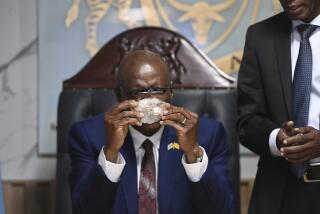Sparkle of Diamonds May Undermine Peace in Angola
- Share via
NZAGI, Angola — Elite commandos lazing beneath mango trees, flicking away flies in the stifling heat, are the only outward sign that this town is a potential flash point that could reignite Angola’s civil war.
Located in northeast Angola, Nzagi lies at the heart of Angola’s diamond region--one of the richest in the world and the scene of recent fighting between government troops and former UNITA rebels.
Although the two sides share power in a coalition government created last April, sharing wealth is a different matter.
UNITA--an acronym for the National Union for the Total Independence of Angola--is dragging its feet on relinquishing control of its diamond-mining operations to the government as called for by a U.N.-brokered peace accord.
The standoff erupted in June, when government troops ousted UNITA soldiers from Nzagi and surrounding towns in a series of clashes. UNITA still claims control over more than half of diamond-rich Lunda Norte province.
Analysts estimate the mining operation earns between $250 million and $500 million annually.
Set in fertile, rolling bushland, Nzagi was once a thriving diamond center. But the infrastructure of the southwestern African nation was shattered in the war that broke out in 1975 upon Angola’s independence from Portugal. Half a million people were killed in the war, which ended, except for occasional flare-ups, in 1994.
Today, the imposing colonial townhouses are crumbling and shantytowns have sprung up on the outskirts. The decay belies the potential riches underground.
About 20 miles outside Nzagi, at the confluence of two rivers, is earth that is said to yield as much as six carats of diamond per cubic yard--which would make it among the richest for diamonds anywhere. Each carat can fetch up to $400.
On a recent day, an official from the state diamond company Endiama and a group of foreign diamond traders looked on as groups of “garimpeiros”--prospectors whose work is illegal but largely tolerated--toiled with shovels and pans in red soil. Some dug as deep as 15 feet, turning the earth into a scarlet moonscape with craters and mounds of soil.
Although UNITA and the government have clashed over the diamond region, they are secretly negotiating carving up the diamond deposits, officials from both sides say.
Companies from Russia, Brazil, Australia, Canada and South Africa are trying to snare concessions, said Des Kilalea, a diamond analyst at Johannesburg-based Fleming Martins.
“Everyone wants a piece of the action,” Kilalea said in a telephone interview. “It is one of the most interesting areas for prospecting in the world. The diamonds are of high quality and the country is reasonably underexplored because of the war.”
While UNITA’s dispute with the government over the diamond region can unravel Angola’s peace process, it also represents a key to the nation’s recovery.
Tax revenues from diamond mining could go a long way toward rebuilding the country. Even though the surface of diamond production has barely been scratched, Angola is the world’s fourth-largest producer of rough diamonds.
Mined diamonds are supposed to be taken to local buying houses, which report the quantity to Endiama. Endiama then levies taxes of more than 50% on the value.
But smuggling has prevented the government from earning full revenue from diamond production under its control.
A million dollars’ worth of diamonds can fit into the pocket of a smuggler, who can hike across the border into Congo, just 6 miles from Nzagi. Airstrips dot the landscape with private planes waiting to spirit away loads of diamonds.
Although the region’s remoteness makes the diamond trade difficult to police, the minister for geology and mines, Marco Samondo, said he plans to beef up security to curtail smuggling.
“We need to crack down on the illegal activities and bring the industry into line,” Samondo said. “Then we can really take off.”
More to Read
Sign up for Essential California
The most important California stories and recommendations in your inbox every morning.
You may occasionally receive promotional content from the Los Angeles Times.









